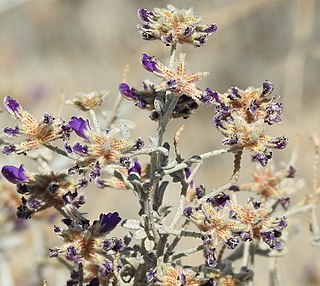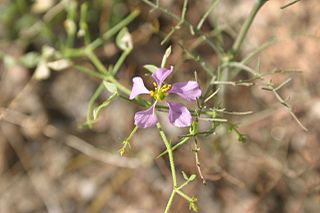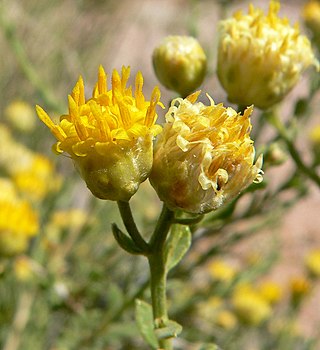
Larrea tridentata, called creosote bush and greasewood as a plant, chaparral as a medicinal herb, and gobernadora in Mexico, due to its ability to secure more water by inhibiting the growth of nearby plants. In Sonora, it is more commonly called hediondilla; Spanish hediondo = "smelly".

Ambrosia dumosa, the burro-weed or white bursage, a North American species of plants in the family Asteraceae. It is a common constituent of the creosote-bush scrub community throughout the Mojave desert of California, Nevada, and Utah and the Sonoran Desert of Arizona and northwestern Mexico.

Eriogonum fasciculatum is a species of wild buckwheat known by the common names California buckwheat and flat-topped buckwheat. Characterized by small, white and pink flower clusters that give off a cottony effect, this species grows variably from a patchy mat to a wide shrub, with the flowers turning a rusty color after blooming. This plant is of great benefit across its various habitats, providing an important food resource for a diversity of insect and mammal species. It also provides numerous ecosystem services for humans, including erosion control, post-fire mitigation, increases in crop yields when planted in hedgerows, and high habitat restoration value.

Geraea canescens, commonly known as desert sunflower, hairy desert sunflower, or desert gold, is an annual plant in the family Asteraceae. The genus name comes from the Greek geraios, referring to the white hairs on the fruits.

Ferocactus cylindraceus is a species of barrel cactus which is known by several common names, including California barrel cactus, Desert barrel cactus, and miner's compass. It was first described by George Engelmann in 1853.

Atriplex hymenelytra, the desert holly, is silvery-whitish-gray shrub in the family Amaranthaceae, native to deserts of the southwestern United States. It is the most drought tolerant saltbush in North America. It can tolerate the hottest and driest sites in Death Valley, and remains active most of the year.

Trixis californica , the American threefold or American trixis, is a species of flowering plant in the family Asteraceae. It is native to the southwestern United States in California, Arizona, New Mexico, and Texas, and in Mexico in the states of Baja California, Chihuahua, Coahuila, Durango, Nuevo León, Sinaloa, Sonora, Tamaulipas, and Zacatecas.

Condea emoryi, the desert lavender, is a large, multi-stemmed shrub species of flowering plant in Lamiaceae, the mint family.

Psorothamnus emoryi, common names dyebush, white dalea, or Emory's indigo bush, is a perennial legume shrub or subshrub common to the desert mesas of the southern part of the U.S. states of Arizona and California, and regions of the Mexican state of Baja California.

Krameria bicolor is a perennial shrub or subshrub of the family Krameriaceae, the rhatanies. It is commonly known as white rhatany, crimson-beak, and chacate in Spanish. It is found in drier environments of the southwestern United States from California to Texas, and in northern Mexico.

Hibiscus denudatus is a perennial shrub of the mallow family, Malvaceae. It is in the rosemallow genus, Hibiscus.

Isocoma acradenia is a North American species of flowering plant in the family Asteraceae known by the common name alkali goldenbush.

Fagonia pachyacantha is a species of flowering plant in the caltrop family known by the common name sticky fagonbush. It is native to the Sonoran Desert of northwest Mexico in Sonora and the Lower Colorado River Valley area at the California and Arizona border.

Senecio mohavensis, known by the common name Mojave ragwort, is a species of flowering plant in the aster family.

Tetracoccus hallii is a species of flowering shrub in the family Picrodendraceae, known by the common names Hall's shrubby-spurge and Hall's tetracoccus.
Xylorhiza cognata is a rare species of flowering plant in the family Asteraceae known by the common names Mecca-aster and Mecca woodyaster.

Acamptopappus sphaerocephalus is a species of flowering plant in the family Asteraceae known by the common name rayless goldenhead. It is native to the southwestern United States, where it occurs in southern California, southern Nevada, southern Utah, and Arizona.

Ambrosia salsola, commonly called cheesebush, winged ragweed, burrobush, white burrobrush, and desert pearl, is a species of perennial shrub in the family Asteraceae native to deserts of the southwestern United States and northwestern Mexico.

Syntrichopappus fremontii, is a small annual plant in the family(Asteraceae. It has yellow flower heads and grows in the Mojave Desert, to Utah and northwestern Arizona.



















